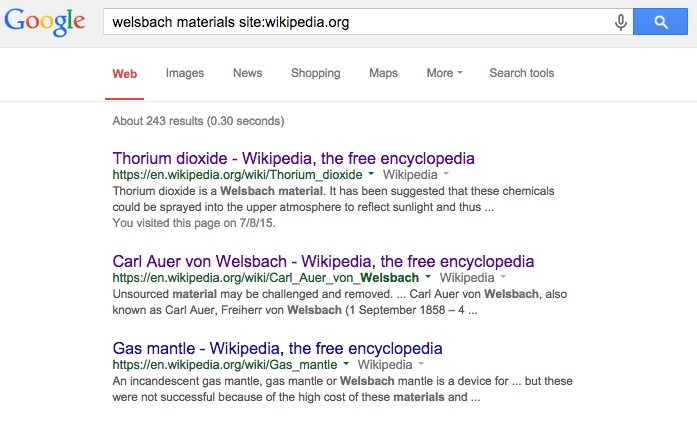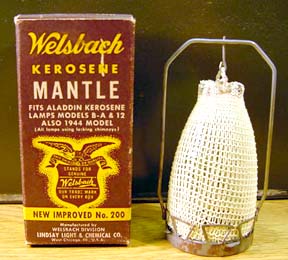JFDee
Senior Member.
There is a relatively recent article in the German Wikipedia about the theoretical base of the famous Welsbach patent which is often quoted by chemtrail believers.
The article's critique in a very small nutshell: Welsbach materials can't emit light without being considerably heated. They wouldn't be able to convert weak heat radiation to light, instead would act as a heat trap themselves.
No English version is available (yet), so I took a stab at translating the central paragraphs. Some - but not all - original links are included and 'translated' to their English equivalents. Additions in bracket by myself.
Original article (in German): Welsbach-Patent
Translation
Note: authorship of this Wikipedia article can be attributed to Mario Sedlak (diploma in Technical Mathematics from TU Vienna) who is interested in the contrail/chemtrail discussion. He has contributed an excellent round-up of the chemtrail conspiracy theory in the German skeptic's magazine "Skeptiker", issue 1/2016.
The article's critique in a very small nutshell: Welsbach materials can't emit light without being considerably heated. They wouldn't be able to convert weak heat radiation to light, instead would act as a heat trap themselves.
No English version is available (yet), so I took a stab at translating the central paragraphs. Some - but not all - original links are included and 'translated' to their English equivalents. Additions in bracket by myself.
Original article (in German): Welsbach-Patent
Alleged principle
The name of the patent refers to the incandescent mantle which Carl Auer von Welsbach invented back in the 19th century [for gas lighting]. The basic idea of the patented method is that small particles with an emission spectrum similar to the material in this mantle are distributed by aircraft. In the visible range of light their emissivity is high, in the near-infrared area it's low and in far-infrared it's high again, as shown in the adjacent graph [see original article].
The inventors believed that such particles would be able to absorb the thermal radiation of the earth which contains mainly deep infrared, and then emit the gathered energy at least partially in the form of visible light.
Visible light does hardly interact with greenhouse gases, so the greenhouse effect would be reduced if the particles were able to absorb energy from far-infrared wavelengths and emit it in shorter wavelengths.
Doubts about the feasibility
According to Kirchhoff's law of radiation, a high emissivity is associated with a high degree of absorption, and vice versa. The particles with the proposed emission spectrum would therefore act like a greenhouse gas as they are expected to absorb the thermal radiation of the earth's surface. Entirely passive bodies without any source of energy and in local thermodynamic equilibrium with their environment cannot amplify individual wavelength ranges from the equilibrium radiation around them or move them to other wavelength ranges, because that would conflict with the Second Law of Thermodynamics.
Planck's radiation law provides an upper bound for the thermal radiation that a body with a given temperature can deliver in a specific wavelength range, when emitting electromagnetic waves solely because of its temperature. At temperatures occurring in the Earth's atmosphere, the maximum proportion of visible light which a purely thermal radiator can emit is negligible according to Planck's radiation law.
If the proposed particles could produce only a little more visible light than Planck's law permits, then this light could be converted to electric power by means of a photovoltaic system. Therefore useable energy would be gained from ambient heat, which would constitute a perpetual motion machine of the second kind. A realization of the invention, as described in the patent text, thus appears not to be physically possible.
The name of the patent refers to the incandescent mantle which Carl Auer von Welsbach invented back in the 19th century [for gas lighting]. The basic idea of the patented method is that small particles with an emission spectrum similar to the material in this mantle are distributed by aircraft. In the visible range of light their emissivity is high, in the near-infrared area it's low and in far-infrared it's high again, as shown in the adjacent graph [see original article].
The inventors believed that such particles would be able to absorb the thermal radiation of the earth which contains mainly deep infrared, and then emit the gathered energy at least partially in the form of visible light.
Visible light does hardly interact with greenhouse gases, so the greenhouse effect would be reduced if the particles were able to absorb energy from far-infrared wavelengths and emit it in shorter wavelengths.
Doubts about the feasibility
According to Kirchhoff's law of radiation, a high emissivity is associated with a high degree of absorption, and vice versa. The particles with the proposed emission spectrum would therefore act like a greenhouse gas as they are expected to absorb the thermal radiation of the earth's surface. Entirely passive bodies without any source of energy and in local thermodynamic equilibrium with their environment cannot amplify individual wavelength ranges from the equilibrium radiation around them or move them to other wavelength ranges, because that would conflict with the Second Law of Thermodynamics.
Planck's radiation law provides an upper bound for the thermal radiation that a body with a given temperature can deliver in a specific wavelength range, when emitting electromagnetic waves solely because of its temperature. At temperatures occurring in the Earth's atmosphere, the maximum proportion of visible light which a purely thermal radiator can emit is negligible according to Planck's radiation law.
If the proposed particles could produce only a little more visible light than Planck's law permits, then this light could be converted to electric power by means of a photovoltaic system. Therefore useable energy would be gained from ambient heat, which would constitute a perpetual motion machine of the second kind. A realization of the invention, as described in the patent text, thus appears not to be physically possible.
Note: authorship of this Wikipedia article can be attributed to Mario Sedlak (diploma in Technical Mathematics from TU Vienna) who is interested in the contrail/chemtrail discussion. He has contributed an excellent round-up of the chemtrail conspiracy theory in the German skeptic's magazine "Skeptiker", issue 1/2016.
Last edited:


